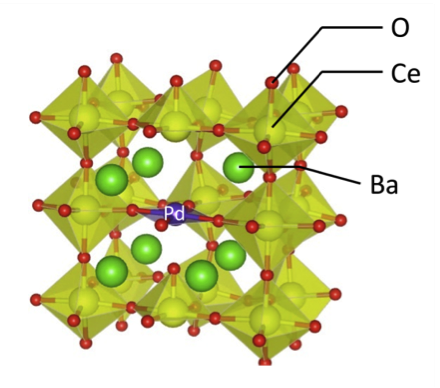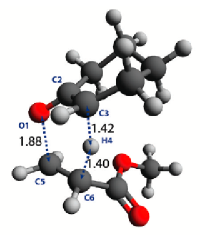|
N. Moghadam, S. Liu, S. Srinivasan, M. C. Grady, M. Soroush, and A. M. Rappe, "Computational study of chain transfer to monomer reactions in high-temperature polymerization of alkyl acrylates", J. Phys. Chem. A 117, 2605-18 (2013).
PDF
|
|
S. Liu, S. Srinivasan, M. C. Grady, M. Soroush, and A. M. Rappe,
"Computational Study of Cyclohexanone-Monomer Co-initiation
Mechanism in Thermal Homo-polymerization of Methyl Acrylate and
Methyl Methacrylate",
J. Phys. Chem. A 116, 5337-48 (2012).
PDF
|
|
S. Kim, M. Rutenberg-Schoenberg, and A. M. Rappe,
"Kinetics of palladium particles on LiNbO3: an origin of
the polarizationdependent catalysis",
MRS Proceedings 1397, 12-01 (1-7) (2012).
PDF
|
|
T. Rier, S. Srinivasan, M. Soroush, G. A. Kalfas, M. C. Grady, and
A. M. Rappe,
"Macroscopic Mechanistic Modeling and Optimization of a Self-Initiated
High-Temperature Polymerization Reactor",
IEEE, 3071-6 (2011).
PDF
|
|
S. Kim, M. Rutenberg Schoenberg, and A. M. Rappe,
"Polarization Dependence of Palladium Deposition on Ferroelectric Lithium Niobate (0001) Surfaces", Phys.
Rev. Lett. 107, 076102 (1-5) (2011).
PDF
Supplementary material
PDF
|
|
S. Srinivasan, M. W. Lee, M. C. Grady, M. Soroush, and A. M. Rappe,
"Computational evidence for self-initiation in spontaneous
high-temperature polymerization of methyl methacrylate", J. Phys. Chem. A
115, 1125-32 (2011).
PDF
|
|
S. Srinivasan, M. W. Lee, M. C. Grady, M. Soroush, and A. M. Rappe,
"Self-Initiation Mechanism in Spontaneous Thermal Polymerization of
Ethyl and n-Butyl Acrylate: A Theoretical Study", J. Phys. Chem. A
114, 7975-83 (2010).
PDF
|
|
S. Srinivasan, M. W. Lee, M. C. Grady, M. Soroush, and A. M. Rappe,
"Computational Study of the Self-Initiation Mechanism in
Thermal Polymerization of Methyl Acrylate", J. Phys. Chem. A
113, 10787-94 (2009).
PDF
|
|
S. E. Mason, E. A. Sokol, V. R. Cooper, and A. M. Rappe,
"Spontaneous Formation of Dipolar Metal Nanoclusters",
J. Phys. Chem. A 113, 4134-7 (2009).
PDF
|
|
D. Li, M. H. Zhao, J. Garra, A. M. Kolpak, A. M. Rappe,
D. A. Bonnell, and J. M. Vohs, "Direct in situ determination
of the polarization dependence of physisorption on ferroelectric
surfaces," Nat. Mat. 7 473-7 (2008).
PDF
|
| S. E. Mason, I. Grinberg, and A. M. Rappe, "Orbital-specific
Analysis of CO Chemisorption on Transition-Metal Surfaces",
J. Phys. Chem. C 112, 1963-6 (2008).
PDF |
|
A. M. Kolpak, I. Grinberg, and A. M. Rappe,
"Polarization effects on the surface chemistry of PbTiO3-supported Pt films",
Phys. Rev. Lett. 98 166101 (1-4) (2007).
PDF
|
|
U. G. Singh, J. Li, J. W. Bennett, A. M. Rappe,
R. Seshadri, and S. L. Scott, "A Pd-doped perovskite catalyst,
BaCe1-xPdxO3-δ
for CO Oxidation", J. Catal. 249, 349-58 (2007).
PDF
|
|
J. Li, U. G. Singh, J. W. Bennett, K. Page,
J. Weaver, J.-P. Zhang, T. Proffen,
A. M. Rappe, S. Scott, and R. Seshadri,
"BaCe1-xPdxO3-δ (0≤x≤ 0.1): Redox controlled ingress and
egress of palladium in a perovskite", Chem. Mater. 19, 1418-26
(2007).
PDF
|
|
V. R. Cooper, A. M. Kolpak, Y. Yourdshahyan, and A. M. Rappe,
"Oxide-supported metal thin-film catalysts: the how and why?",
Nanotechnology in catalysis, Vol. 3, B.
Zhou, ed., Springer-Verlag New York, pp. 13-21 (2006).
PDF
|
|
S. E. Mason, I. Grinberg and A. M. Rappe,
"Adsorbate-adsorbate interactions and chemisorption at different
coverages studied by accurate ab initio calculations: CO on transition
metal surfaces", J. Phys. Chem. B 110, 3816-22 (2006).
PDF
|
|
V. R. Cooper, A. M. Kolpak, Y. Yourdshahyan, and A. M. Rappe,
"Supported metal electronic structure: implications for molecular
adsorption", Phys. Rev. B Rapid Comm. 72, 081409(R) (1-4)
(2005). Selected for the Virtual Journal of Nanoscale Science
and Technology, September 12, 2005 issue.
PDF
|
|
M.-L. Bocquet, A. M. Rappe, and H.-L. Dai, "A density
functional theory study of adsorbate-induced work function change and
binding energy: Olefins on Ag(111)", Molecular Physics 103, 883-90
(2005).
PDF
|
|
Y. Yourdshahyan, V. R. Cooper, A. M. Kolpak, and
A. M. Rappe, "Catalytic behavior at the nanoscale: CO adsorption on
Al2O3-supported
Pt clusters", Proc. SPIE 5223, 223-31 (2004).
PDF
|
|
S. E. Mason, I. Grinberg, and A. M. Rappe, " First-principles
extrapolation method for accurate CO adsorption energies on metal
surfaces", Phys. Rev. B Rapid Comm. 69, 161401R (1-4) (2004).
PDF
|
|
E. J. Walter and A. M. Rappe, "Coadsorption of methyl radicals
and oxygen on Rh (111)", Surf. Sci. 549, 265-72 (2004).
PDF
|
|
R. P. Kauffman and A. M. Rappe, ``Vacancies below the (111) surface
of Pd'', Phys. Rev. B 67, 085403 (1-6) (2003).
PDF
|
|
Y. Yourdshahyan and A. M. Rappe, ``Structure and energetics of
alkanethiol adsorption on the Au(111) surface'', J. Chem. Phys. 117, 825-33 (2002).
PDF
|
|
I. Grinberg, Y. Yourdshahyan, and A. M. Rappe, ``CO on Pt(111)
puzzle: A possible solution'', J. Chem. Phys. 117, 2264-2270
(2002).
PDF
|
|
X. Lin, N. J. Ramer, A. M. Rappe, K. Hass, W. F. Schneider, and B. L.
Trout, ``Effect of Particle Size on the Adsorption of O and S Atoms on Pt: a
Density Functional Study'', J. Phys. Chem. B 105, 7739-7747 (2001).
PDF
|
|
E. J. Walter, S. P. Lewis, and A. M. Rappe, ``First-principles
study of carbon monoxide adsorption on zirconia-supported copper'',
Surf. Sci. 495, 44-50 (2001).
PDF
|
Y. Yourdshahyan, H. K. Zhang, and A. M. Rappe, `` -Alkyl thiol group
interactions with the Au (111) surface'', Phys. Rev. B Rapid
Comm. 081405 (1-4) (2001).
PDF -Alkyl thiol group
interactions with the Au (111) surface'', Phys. Rev. B Rapid
Comm. 081405 (1-4) (2001).
PDF
|
|
E. J. Walter, S. P. Lewis, and A. M. Rappe,
``Investigation of chemisorbed molecular states for oxygen on
rhodium (111)'', J. Chem. Phys. 113, 4388-4391 (2000).
PDF
|
|
E. J. Walter and A. M. Rappe,
``Accurate and efficient determination of chemisorption energies
using pseudopotentials,'' Surf. Sci. 427-428, 11-14 (1999).
PDF
|
|
S. P. Lewis and A. M. Rappe,
``Structural and vibrational properties of carbon monoxide
adlayers on the copper (001) surface'', J. Chem. Phys. 110, 4619-4633 (1999).
PDF
|
|
E. J. Walter, S. P. Lewis, and A. M. Rappe,
"Internally consistent predictions of
surface structural relaxations", Laser Techniques for Surface Science
III, Proc. SPIE 3272, 196-200 (1998).
PDF
|
|
S. P. Lewis, M. V. Pykhtin, E. J. Mele, and A. M. Rappe,
"Continuum elastic theory of adsorbate vibrational relaxation",
J. Chem. Phys. 108, 1157-61 (1998).
PDF
|
|
S. P. Lewis and A. M. Rappe,
"Bonding and vibrational properties of CO-adsorbed copper",
Symposium Mater. Res. Soc. 391-9 (1996).
PDF
PDF
|
|
S. P. Lewis and A. M. Rappe,
"Substrate-adsorbate coupling in CO-adsorbed copper", Phys. Rev. Lett. 77, 5241-4 (1996).
PDF
|
|
S. P. Lewis
and A. M. Rappe, "Quantum-mechanical investigation of bonding and vibrational
properties of CO-adsorbed copper", Proc. SPIE 2547, 227-39
(1995).
PDF
|



